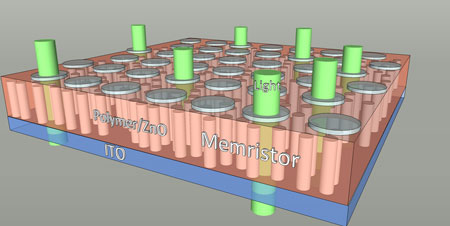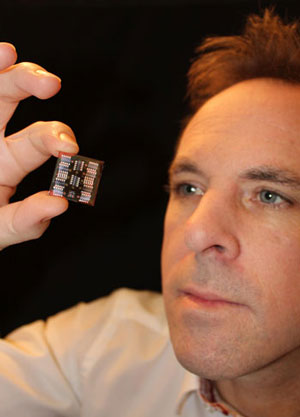| Posted: Oct 30, 2017 | |
Reversibly controlling the learning properties of memristors via optical means |
|
| (Nanowerk Spotlight) Memristors – or resistive memory – are nanoelectronic devices that are very promising components for next generation memory and computing devices. They are two-terminal electric elements similar to a conventional resistor – however, the electric resistance in a memristor is dependent on the charge passing through it; which means that its conductance can be precisely modulated by charge or flux through it. Its special property is that its resistance can be programmed (resistor function) and subsequently remains stored (memory function). | |
| In this sense, a memristor is similar to a synapse in the human brain because it exhibits the same switching characteristics, i.e. it is able, with a high level of plasticity, to modify the efficiency of signal transfer between neurons under the influence of the transfer itself. That's why researchers are hopeful to use memristors for the fabrication of electronic synapses for neuromorphic (i.e. brain-like) computing that mimics some of the aspects of learning and computation in human brains. | |
| Human brains may be slow at pure number crunching but they are excellent at handling fast dynamic sensory information such as image and voice recognition. Walking is something that we take for granted but this is quite challenging for robots, especially over uneven terrain. | |
| Computers also still have a long way to go in developing abilities such as creativity, understanding complex tasks or making decisions in ambiguous situations. VLSI techniques have tried to emulate the abilities of human thinking for many years. Perhaps the most famous example is of IBM's Watson computer, which beat two players on the quiz show Jeopardy. This was quite an accomplishment, however these computers are very large and consume enormous power. In contrast, the human brain is very compact (∼1.4 kg), it consumes very little power (only about 10-25 Watts), it works well even if components fail, and it seems to work without any software. | |
| Not only are memristors potential competitors for SRAM and DRAM as they are very fast at switching, are scalable down to the nanoscale, and consume ultra-low levels of power (their non-volatile operation means they do not consume power when not in use – like FLASH memory), they also exhibit the same switching characteristics as synapses in the human brain. | |
| "Memristors present an opportunity to make new types of computers that are different from existing von Neumann architectures, which traditional computers are based upon," Dr Neil T. Kemp, a Lecturer in Physics at the University of Hull, tells Nanowerk. "Our team at the University of Hull is focussed on making memristor devices dynamically reconfigurable and adaptive – we believe this is the route to making a new generation of artificial intelligence systems that are smarter and can exhibit complex behavior. Such systems would also have the advantage of memristors, high density integration and lower power usage, so these systems would be more lightweight, portable and not need re-charging so often – which is something really needed for robots etc." | |
 |
|
| Schematic of the memristor device consisting of a hybrid material made from ZnO nanorods and a poly(disperse red 1 acrylate) polymer. (University of Hull) | |
| In their new paper in Nanoscale ("Reversible Optical Switching Memristors with Tunable STDP Synaptic Plasticity: A Route to Hierarchical Control in Artificial Intelligent Systems"), Kemp and his team demonstrate the ability to reversibly control the learning properties of memristors via optical means. | |
| The reversibility is achieved by changing the polarization of light. The researchers have used this effect to demonstrate tuneable learning in a memristor. One way this is achieved is through something called Spike Timing Dependent Plasticity (STDP), which is an effect known to occur in human brains and is linked with sensory perception, spatial reasoning, language and conscious thought in the neocortex. | |
| STDP learning is based upon differences in the arrival time of signals from two adjacent neurons. The University of Hull team has shown that they can modulate the synaptic plasticity via optical means which enables the devices to have tuneable learning. | |
| "Our research findings are important because it demonstrates that light can be used to control the learning properties of a memristor," Kemp points out. "We have shown that light can be used in a reversible manner to change the connection strength (or conductivity) of artificial memristor synapses and as well control their ability to forget i.e. we can dynamically change a device to have short-term or long-term memory." | |
| Since this can be done dynamically it would allow computational systems to fine-tune their learning characteristics for different functional needs (e.g. vision or audio recognition) or changes in computational demands. | |
| According to the team, there are many potential applications, such as adaptive electronic circuits controllable via light, or in more complex systems, such as neuromorphic computing, the development of optically reconfigurable neural networks. | |
| Having optically controllable memristors can also facilitate the implementation of hierarchical control in larger artificial-brain like systems, whereby some of the key processes that are carried out by biological molecules in human brains can be emulated in solid-state devices through patterning with light. | |
| Some of these processes include synaptic pruning, conversion of short term memory to long term memory, erasing of certain memories that are no longer needed or changing the sensitivity of synapses to be more adept at learning new information. | |
| Light could also be used to pattern large arrays of memristors into regions just like the human brain. Each region would have different learning properties for specific needs, e.g. learning to walk, facial recognition, understanding speech or regions for short term memory and long term memory. | |
| "The ability to control this dynamically, both spatially and temporally, is particularly interesting since it would allow neural networks to be reconfigurable on the fly through either spatial patterning or by adjusting the intensity of the light source," notes Kemp. | |
| He adds that the modulation of the electrical properties of memristors by light provides a new level of functionality. "There are many new types of device and circuits that could be developed. For instance in optoelectronics, new types of optical switches could be made for integrated photonic circuits and adaptive electronics. In this case the switching speed would need to dramatically improve." | |
 |
|
| Dr Neil Kemp, Lecturer in Physics at the University of Hull holds an optically tuneable memristor device that his team and collaborators have developed. (University of Hull) | |
| Currently, the devices are more suited to neuromorphic computing applications, which do not need to be as fast. Optical control of memristors opens the route to dynamically tuneable and reprogrammable synaptic circuits as well the ability (via optical patterning) to have hierarchical control in larger and more complex artificial intelligent systems. | |
| Since light patterning is a parallel process it could also be used as a means to transfer stored information (or the state of the synaptic plasticity) between neural memory arrays, potentially enabling the mass production of neural circuits and eliminating the need of training devices post-production. | |
| The scientists have already increased the sensitivity of devices to light so they exhibit 3 or 4 orders of magnitude change in their conductivity. Their next stage is to improve the switching speed of the device. Their initial target is millisecond switching, which seems rather slow, but these speeds are similar to the switching/signalling speeds used in biological systems. | |
| "Artificial Intelligence is really starting to come on strong in many areas, especially in voice/image recognition and autonomous systems – we could even say that this is the next revolution, similarly to what the industrial revolution was to farming and production processes," concludes Kemp. "There are many challenges to overcome though. For instance, it is getting more and more difficult to increase computational power because it is very difficult to keep reducing the size of transistors. The potential end of Moore's Law is now very close. Most likely new types of computers will need to be developed (e.g. quantum computers) and it may be that until this happens advances in computation lie in combining aspects of both traditional von Neumann computing with new neuromorphic computing approaches." | |
 By
Michael
Berger
– Michael is author of three books by the Royal Society of Chemistry:
Nano-Society: Pushing the Boundaries of Technology,
Nanotechnology: The Future is Tiny, and
Nanoengineering: The Skills and Tools Making Technology Invisible
Copyright ©
Nanowerk LLC
By
Michael
Berger
– Michael is author of three books by the Royal Society of Chemistry:
Nano-Society: Pushing the Boundaries of Technology,
Nanotechnology: The Future is Tiny, and
Nanoengineering: The Skills and Tools Making Technology Invisible
Copyright ©
Nanowerk LLC
|
|
|
Become a Spotlight guest author! Join our large and growing group of guest contributors. Have you just published a scientific paper or have other exciting developments to share with the nanotechnology community? Here is how to publish on nanowerk.com. |
|
